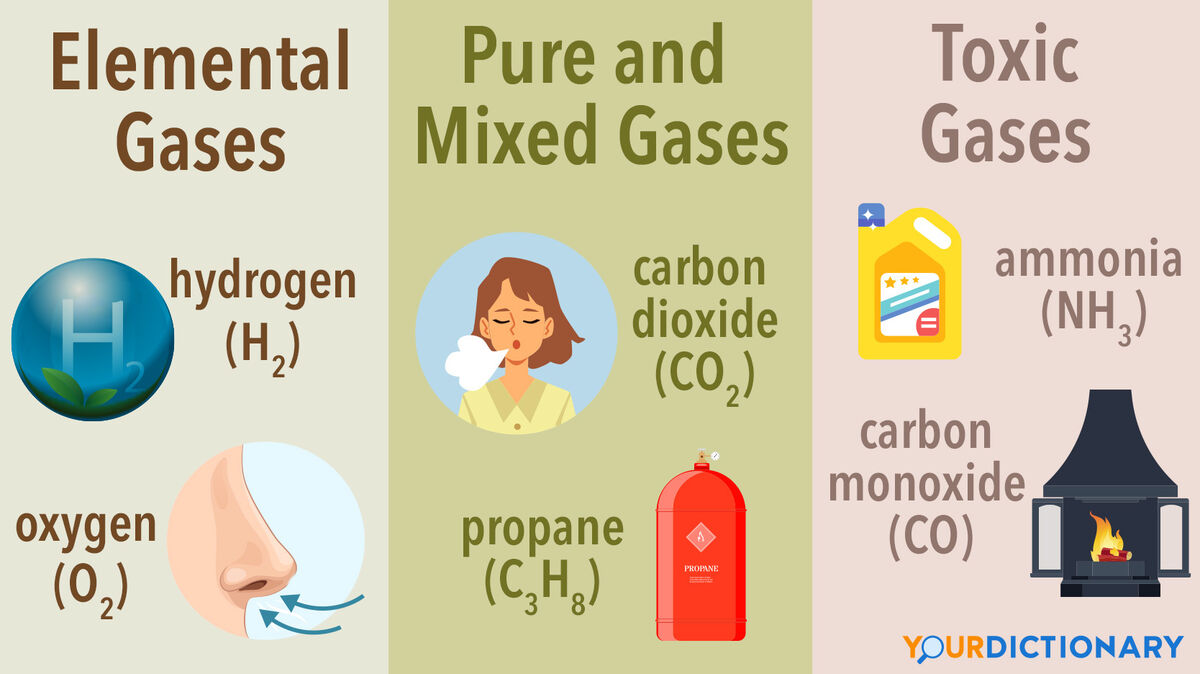
You probably know that gas is one of the three states of matter. But unlike solids and liquids, the other two states of matter, gases have no defined volume outside the container they're in. Many elements exist as gases at standard temperature and pressure, while other elements and compounds can become gases under certain circumstances. Take a look at several examples of gas in different contexts, organized by types of gases.
Elemental Gases
Certain elements exist as gases at standard temperature and pressure. When the pressure is changed and is higher or lower, or when the temperature is changed and is higher or lower, the element may exist in a different form such as in liquid form or solid form.
Examples of elemental gases include:
- hydrogen (H2)
- nitrogen (N)
- oxygen (O2)
- fluorine (F2)
- chlorine (Cl2)
- helium (He)
- neon (Ne)
- argon (Ar)
- krypton (Kr)
- xenon (Xe)
- radon (Rn)
The monogamic noble gases are helium, neon, argon, krypton, radon and xenon. When paired with the other gases on the list, these gases are known as the elemental gases.
Pure and Mixed Gases
Pure gases can take several forms. They might be made up of individual atoms, such as neon, or they can be made up of atomic gases or noble gases. Mixed gases, on the other hand, consist of more than one kind of pure gas. In the Earth's atmosphere, for example, there is a wide mix of different gases including oxygen and other atoms that are released.
Some examples of pure gases and mixed gases include:
- acetylene (C2H2)
- air
- butane (C₄H₁₀)
- carbon dioxide (CO2)
- deuterium (2H)
- dimethyl ether (C2H6O)
- ethane (C2H6)
- germane (GeH4)
- hexane (C6H14)
- isobutane (C4H10)
- methane/natural gas (CH₄)
- nitrous oxide (N2O)
- propane (C3H8)
- propylene glycol (C3H8O2)
- sulfur hexafluoride (SF6)
Pure gases may also be compound molecules, which are comprised of a bunch of different atoms. For example, carbon dioxide would be considered a pure gas but it is also a compound molecule.
Toxic Gases
Toxic gases can cause harm when they are breathed in or when people are exposed to them. In some cases, breathing in a toxic gas, even for a few seconds, can result in severe injury death. In other instances, breathing in a toxic gas just might make you feel sick or light-headed.
Check out a list of gases considered to be toxic:
- ammonia (NH3)
- arsenic (As)
- arsine (AsH3)
- benzene (C6H6)
- boron trifluoride (BF3)
- bromine (Br)
- bromine chloride (BrCl)
- bromomethane (CH3Br)
- butadiene 1,3 (C4H6)
- carbon monoxide (CO)
- chlorine pentafluoride (ClF5)
- chlorine trifluoride (ClF3)
- chlorofluorocarbons
- diborane (B2H6)
- ethylene oxide (C2H4O)
- formaldehyde (CH2O)
- hydrogen bromide (HBr)
- hydrogen chloride (HCl)
- hydrogen sulfide (H₂S)
- methanol (CH3OH)
- methyl chloride (CH2Cl2)
- nickel tetracarbonyl (Ni(CO)4)
- nitrogen dioxide (NO₂)
- nitrogen trifluoride (NO3)
- osmium tetroxide (OsO4)
- ozone (O₃)
- perfluoroisobutylene (C4F8)
- phosgene (COCl2)
- phosphine (PH3)
- silane (SiH4)
- silicon tetrachloride (SiCl4)
- sulfur dioxide (SO₂)
- sulfur tetrafluoride (SF4)
- trichlorosilane (HCl3Si)
- trimethlyamine (C3H9N)
- tungsten hexafluoride (WF6)
- vinyl chloride (C2H3Cl)
Breathing in a toxic gas for just a short time can result in long-term damage, so seek help as soon as possible if you've been exposed to a toxic gas. If you're not sure about the toxicity of a particular gas, it's advisable to consult poison control or your local medical professional.
The Stages of Matter Really Matter
Every day, we encounter gases, not just in a science lab, but in the air that we breathe and the world that we live in. It's important to know which of these gases are elemental, pure or mixed, or toxic so you can best protect yourself. For more information on the different stages of matter, explore examples of physical properties of matter. You can also learn how gas becomes solid (and how other stages of matter change phases).